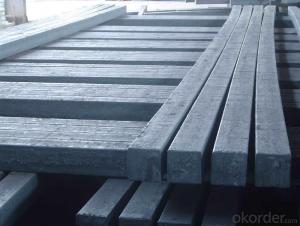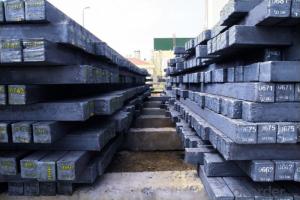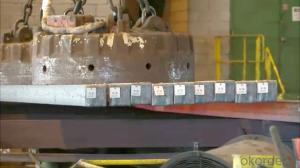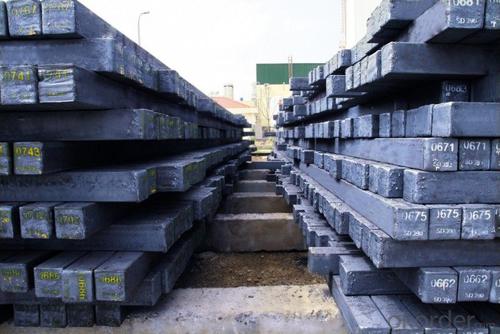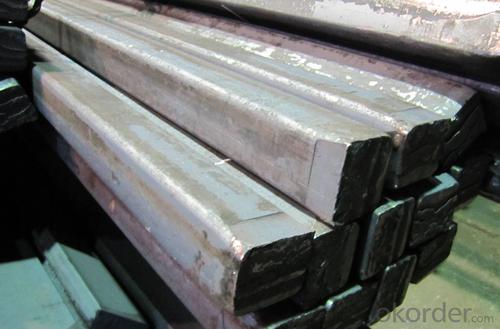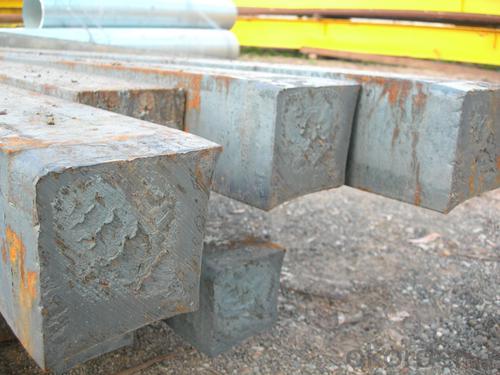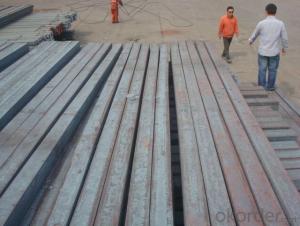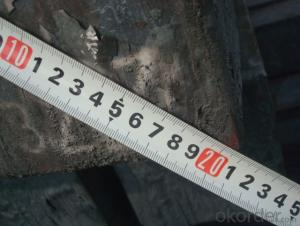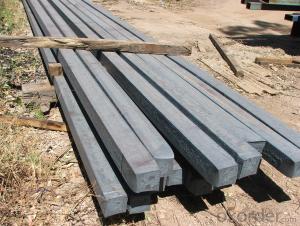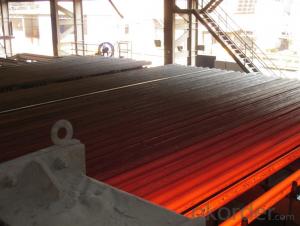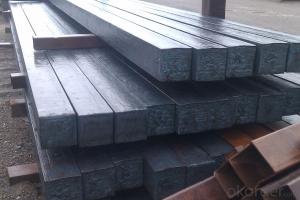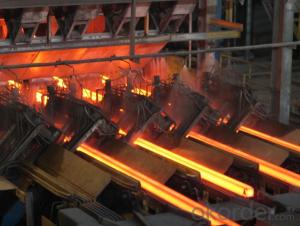Prime Q275 155mm Square Alloy Steel Billet
- Loading Port:
- Shanghai
- Payment Terms:
- TT OR LC
- Min Order Qty:
- 100 m.t.
- Supply Capability:
- 10000 m.t./month
OKorder Service Pledge
OKorder Financial Service
You Might Also Like
Structure of Prime Q275 155mm Square Alloy Steel Billet

Description of Prime Q275 155mm Square Alloy Steel Billet
1. Prepainted steel coil is coated with organic layer, which provides higher anti-corrosion property and a longer lifespan than that of galvanized or galvalume steel sheets.
2. The base metals for prepainted steel coil consist of cold rolled, HDGI Steel, electro-galvanized and hot-dip alu-zinc coated steel. The finish coats of prepainted steel coil can be classified into groups as follows: polyester, silicon modified polyesters, polyvinylidene fluoride, high-durability polyester, etc.
3. The production process has evolved from one-coating-and-one-baking to double-coating-and-double-baking, and even three-coating-and-three-baking.
4. The color of the prepainted steel coil has a very wide selection, like orange, cream-colored, dark sky blue, sea blue, bright red, brick red, ivory white, porcelain blue, etc.
5. The prepainted steel coils can also be classified into groups by their surface textures, namely regular prepainted sheets, embossed sheets and printed sheets.

Main Feature of Prime Q275 155mm Square Alloy Steel Billet
They were one of several reasons for the wind to be taken out of the sails of the recent oil price momentum. Kuwait’s oil minister said that his country would only commit to a production freeze if all major producers are involved, including Iran. We also had Goldman telling us that oil markets will not rebalance at $40/bbl as it throws a lifeline to cash-strapped US producers.
If it is talk of a production freeze that is behind the rally it shows how low expectations have fallen. It is in the nature of oil people to talk the market up. Any bullish crumb is given exaggerated significance and any port in a storm will do. It is all but fact that the oil market will be tighter in the second half of this year when seasonal demand shoots up and US production continues to decline. It was the same picture last year. If OPEC and key non-OPEC production is frozen that will ensure the daily surplus will fall, but in all likelihood there will still be a surplus and there is an enormous global stockbuild to burn off.
Applications of Prime Q275 155mm Square Alloy Steel Billet
A. Corrugated design makes it excellent waterproof performance
B. Materials as prepainted steel sheets, galvanized steel sheets, galvalume (Al-Zn coated sheets) are available to make corrugated sheet.
C.Those material are durable, anti-corrosion in bad weather for 20-30 years based on it's Zinc(Galvanized) coating or AZ (Galvalume) coating.
D. Different shape of the sheet make it suitable for any style of buildings.
E.Easy to install, no need special tools to fix the sheet.
F.Light weight due to high strength to weight ratio of steel. Light weight means easier handling lower shipping costs, easier installation
G. Different color is availbe base on the RAL Standard make your building more beautiful.
H. We will provide the best solutions if you don't have a exact idea of the specification you want for the steel sheet based on your weather conditions, engineering structure, construction budget and so on.

Specifications of Prime Q275 155mm Square Alloy Steel Billet
Product | Billet |
Material Grade | SGCC / SGCH / DX51D+AZ, etc |
Thickness | 0.6-3.0mm |
Width | 500-1500mm |
Tolerance | Thickness: +/-0.02mm , Width:+/-2mm |
Zinc-coating | Z30-150g/m2 |
Technique | Raw material: Hot rolled steel coil --> Cold rolled_>hot dipped galvalume |
Surface | Dried, Chromated, Unoiled |
Spangle | Regular spangle , small spangle, zero spangle |
ID | 508MM 610MM |
Coil weight | 1-25MT |
Export package | Cardboard inner sleeves, Waterproof paper, galvanized steel covered and steel strip packed |
FAQ of Prime Q275 155mm Square Alloy Steel Billet
We have organized several common questions for our clients,may help you sincerely:
1. How Can I Visit There?
Our company is located in Tianjin City, China, near Beijing. You can fly to Tianjin Airport Directly. All our clients, from home or aboard, are warmly welcome to visit us!
2. How Can I Get Some Sample?
Poor trade figures from China punctured commodity optimism yesterday although they came with warnings that perhaps the numbers were distorted by Chinese New Year celebrations and we will have to wait for the March figures to gain a true picture of the state of China’s landing. Exports for February were -25.4% and imports -13.8% year-on-year.
- Q: What are the different forging methods used for steel billets?
- Steel billets can be forged using different methods, each with its own advantages and applications. Open Die Forging is a method where the steel billet is shaped between flat dies. This allows for flexibility in design and size, making it suitable for larger and more complex parts that require customization, like shafts, cylinders, and discs. Closed Die Forging, also known as impression die forging, involves shaping the steel billet within a set of dies that contain the desired shape. It is ideal for producing high-precision and complex parts with tight tolerances, such as gears, connecting rods, and crankshafts. Upset Forging is a method that involves increasing the cross-sectional area of the steel billet by compressing it between dies. This is commonly used for creating short-length parts like bolts, screws, and fasteners. Roll Forging uses cylindrical rolls to gradually shape the steel billet into the desired form. It is often used to produce long parts with a consistent cross-section, such as bars, rods, and shafts. Press Forging utilizes a hydraulic or mechanical press to shape the steel billet, providing greater control over the forging process. This method is often employed for manufacturing automotive components, aerospace parts, and tools. Isothermal Forging involves heating the steel billet and the dies to the same temperature, reducing the cooling effect during forging. This allows for greater control over the microstructure and mechanical properties of the final product, making it suitable for producing parts that require high strength and temperature resistance. Each forging method has its own benefits, allowing steel billets to be shaped into a wide range of products with varying complexity, size, and mechanical properties. The choice of forging method depends on factors such as the desired product, material properties, production volume, and cost considerations.
- Q: What is the role of steel billets in the manufacturing of conveyor systems?
- The manufacturing of conveyor systems heavily relies on steel billets, which serve as the primary material for producing various components and parts. To begin with, steel billets play a vital role in constructing the framework and structure of the conveyor system. They are shaped and cut to form the main frame, supports, and other structural elements that provide stability and strength to the entire system. The superior strength and durability of steel make it an ideal material for this purpose, ensuring that the conveyor system can withstand heavy loads and operate efficiently. Moreover, steel billets are crucial in the fabrication of rollers and pulleys, which are indispensable components of conveyor systems. These rollers and pulleys are responsible for guiding and moving the conveyor belt, facilitating the smooth and uninterrupted flow of materials. Steel billets are forged and machined to create these components, guaranteeing their reliability and long lifespan even in demanding working conditions. Additionally, steel billets are also utilized in the production of brackets, connectors, and fasteners that secure the different parts of the conveyor system together. These components provide the necessary connections and attachments, ensuring the proper assembly and functioning of the conveyor system. Furthermore, steel billets offer the advantage of being moldable and shapeable into customized parts according to the specific requirements of the conveyor system. This flexibility allows conveyor manufacturers to design and manufacture conveyor systems that are tailored to the unique needs of various industries and applications. In conclusion, steel billets are essential in the manufacturing of conveyor systems as they provide the raw material for constructing the system's framework, rollers, pulleys, brackets, connectors, and other components. The high strength, durability, and flexibility of steel billets make them a vital ingredient in creating reliable and efficient conveyor systems.
- Q: What are the different types of steel billet surface treatments?
- There are several different types of steel billet surface treatments, including pickling, shot blasting, and painting. Pickling involves removing impurities and oxides from the surface of the billet using an acid solution. Shot blasting is a process in which small metallic or abrasive particles are blasted onto the surface of the billet to remove rust, scale, and other contaminants. Painting involves applying a protective coating or layer of paint to the surface of the billet to prevent corrosion and improve its appearance.
- Q: Can steel billets be customized in terms of shape and size?
- Steel billets have the capability to be personalized when it comes to their shape and size. These semi-finished products are typically rectangular in form and are utilized as raw materials for various manufacturing procedures. Nonetheless, they can be modified to fulfill specific requirements through a technique known as billet rolling or cross-rolling. Throughout this procedure, the steel billets are subjected to a series of rolls that are specially designed to exert pressure and force, resulting in their reshaping. This permits the customization of the billets into various shapes and sizes, such as square, round, or hexagonal, depending on the desired final product. Furthermore, the size of the steel billets can also be tailored. The initial dimensions of the billets can be altered by either increasing or decreasing their length, width, and height. This adaptability in customization empowers manufacturers to fabricate steel billets that best suit their specific production requirements. To sum up, steel billets can undoubtedly be customized in terms of both shape and size through the process of billet rolling. This empowers manufacturers to adjust the billets according to their desired specifications, enabling the creation of a wide array of products utilizing steel as a primary material.
- Q: How are steel billets used in the production of automotive frames?
- Steel billets are used in the production of automotive frames as they are heated and shaped into desired forms, such as beams or plates, which are then welded together to create the structural framework of a vehicle.
- Q: Can steel billets be used in the production of automotive components?
- Yes, steel billets can be used in the production of automotive components. Steel billets are raw, semi-finished steel products that can undergo further processing, such as rolling, forging, or machining, to create various automotive parts like engine blocks, suspension components, gears, and more. The use of steel billets allows for the production of high-strength and durable automotive components, making them a popular choice in the automotive industry.
- Q: How are steel billets used in the production of construction components?
- Construction components rely on steel billets as a crucial raw material. These billets are utilized primarily in the creation of various structural elements like beams, columns, and bars, which compose the framework of buildings and infrastructure projects. The process commences with steel billets, semi-finished products formed by casting molten steel into rectangular or square shapes. Subsequently, these billets undergo further processing and transformation into specific construction components through diverse manufacturing techniques. One widespread application of steel billets involves beam production, which is indispensable for supporting the weight of floors, roofs, and walls in buildings. The billets are subjected to rolling mills, where they are heated and passed through a series of rollers to acquire the desired beam profile. This process facilitates the production of beams in varying sizes and lengths, tailored to the unique requirements of each construction project. Steel billets are also employed in the manufacture of columns, which provide vertical support to structures. Similar to beams, billets are processed through rolling mills to achieve the necessary column shape. Subsequently, the columns are connected to the beams, creating the skeletal framework of the building and ensuring strength and stability. Additionally, steel billets find application in the production of reinforcing bars, commonly referred to as rebar, used for reinforcing concrete structures. These rebar play a critical role in enhancing the strength and durability of concrete. Billets are once again processed through rolling mills to create rebar in various diameters and lengths. The rebar is then embedded within the concrete to provide tensile strength, preventing cracking, and increasing the overall structural integrity. In summary, steel billets are pivotal in the production of construction components as they serve as the starting point for the manufacturing process. They are transformed into beams, columns, and rebar, which offer the necessary strength and stability required for building and infrastructure projects.
- Q: What are the common shipping methods for steel billets?
- Steel billets can be shipped using different methods, including container shipping, bulk shipping, and rail transportation. Container shipping is commonly used when transporting smaller quantities of billets. Billets are loaded into standard shipping containers, usually 20 or 40 feet long, and then transported by cargo vessels. This method is convenient and ensures the safety of the billets during transit. Bulk shipping, on the other hand, is preferred for larger quantities of steel billets. In this method, billets are loaded directly onto cargo vessels without using containers. This allows for cost-effective transportation of large volumes of billets. Specialized bulk carriers are designed to handle heavy cargo and ensure secure delivery. For domestic or regional transportation, rail transportation is a popular option. Steel billets are loaded onto specialized railcars that can carry heavy loads, and they are transported through rail networks. This method offers efficient and reliable transportation, especially for shorter distances. Ultimately, the choice of shipping method for steel billets depends on factors such as quantity, destination, cost, and logistical capabilities. Each method has its own advantages and considerations, so it is important to select the most suitable option based on the specific requirements of the shipment.
- Q: What are the potential applications of steel billets in the transportation sector?
- Due to their strength, durability, and versatility, steel billets offer a wide range of potential applications in the transportation sector. One primary use is in the manufacturing of various vehicle components, such as engine parts, suspension systems, axles, and other critical parts that require high strength and resistance to wear and tear. Moreover, steel billets can be utilized in the construction of railway tracks, bridges, and tunnels. With its high tensile strength, steel is an ideal material for infrastructure projects as it can withstand heavy loads and provide long-lasting performance. It is also suitable for manufacturing shipbuilding components like hulls, propellers, and deck structures, offering excellent corrosion resistance and structural integrity in marine environments. Additionally, steel billets find use in the production of transportation equipment like trailers, trucks, and buses. Its strength and durability make it an ideal material for constructing the chassis and frames of these vehicles, ensuring their safety and longevity. In the automotive industry, steel billets are commonly used for producing car bodies and frames. The lightweight yet robust characteristics of steel make it a preferred choice for enhancing fuel efficiency and crashworthiness in vehicles. Furthermore, manufacturers can shape steel billets into intricate designs, allowing them to create aesthetically pleasing and aerodynamic vehicle structures. In conclusion, the strength, durability, and versatility of steel billets make them essential in the transportation sector. They are used in various applications, ranging from vehicle components to infrastructure projects. By ensuring safety, reliability, and longevity, steel billets play a vital role in the industry.
- Q: What are the different heat treatment processes for steel billets?
- There are several different heat treatment processes that can be used for steel billets, each with its own purpose and benefits. Some of the common heat treatment processes for steel billets include annealing, normalizing, quenching, tempering, and case hardening. 1. Annealing: This process involves heating the steel billets to a high temperature and then slowly cooling them to room temperature. The purpose of annealing is to reduce the hardness of the steel, improve its machinability, and relieve internal stresses. It also helps in refining the grain structure, making the steel more ductile and less brittle. 2. Normalizing: In normalizing, the steel billets are heated to a temperature above the critical range and then cooled in still air. This process is used to refine the grain structure, improve mechanical properties, and enhance machinability. Normalizing also helps in relieving internal stresses and achieving uniformity in microstructure. 3. Quenching: Quenching involves rapidly cooling the steel billets by immersing them in a quenching medium such as oil, water, or brine. This process is designed to harden the steel by transforming the austenite phase into martensite. Quenching results in a hard and brittle steel with improved wear resistance, but it also introduces residual stresses and the potential for cracking. 4. Tempering: After quenching, the steel billets are often tempered to reduce brittleness and improve toughness. Tempering involves reheating the quenched steel to a lower temperature and holding it for a specific period of time. This process helps in relieving stresses, reducing hardness, and improving ductility without sacrificing too much strength. 5. Case Hardening: Case hardening is a process used to increase the surface hardness of steel billets while maintaining a tough and ductile core. There are different methods of case hardening, such as carburizing and nitriding. Carburizing involves introducing carbon into the surface of the steel by heating it in a carbon-rich environment, while nitriding introduces nitrogen to form a hard nitride layer on the surface. These processes enhance wear resistance and extend the lifespan of the steel billets. These heat treatment processes for steel billets offer manufacturers the ability to tailor the properties of the steel to meet specific application requirements. By carefully selecting and implementing the appropriate heat treatment process, the resulting steel billets can exhibit a wide range of mechanical properties, such as hardness, strength, toughness, and wear resistance.
Send your message to us
Prime Q275 155mm Square Alloy Steel Billet
- Loading Port:
- Shanghai
- Payment Terms:
- TT OR LC
- Min Order Qty:
- 100 m.t.
- Supply Capability:
- 10000 m.t./month
OKorder Service Pledge
OKorder Financial Service
Similar products
Hot products
Hot Searches
Related keywords
